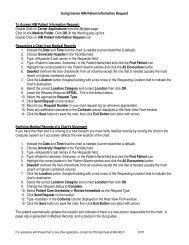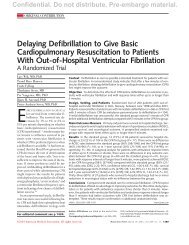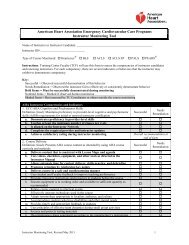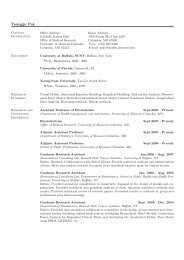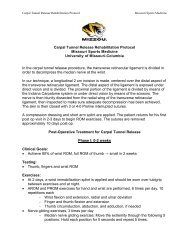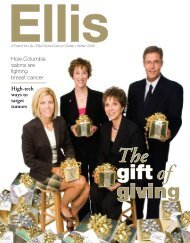A Life-Saving Legacy - University of Missouri Health Sciences Center
A Life-Saving Legacy - University of Missouri Health Sciences Center
A Life-Saving Legacy - University of Missouri Health Sciences Center
Create successful ePaper yourself
Turn your PDF publications into a flip-book with our unique Google optimized e-Paper software.
the Staff For <strong>Life</strong> Helicopter Service transports more than 1,000<br />
patients yearly.<br />
Hospital’s Frank L. mitchell Jr., m.D., trauma center —<br />
which carries his name in gratitude for his contributions to<br />
building central missouri’s only Level I trauma center. What<br />
some people may not know, however, is how far mitchell’s<br />
reputation spreads beyond the borders <strong>of</strong> his home state.<br />
“Frank mitchell is a member <strong>of</strong> an elite group <strong>of</strong> pioneers<br />
who paved the way for trauma care, both nationally<br />
and internationally,” said Stephen barnes, mD, chief <strong>of</strong> the<br />
Division <strong>of</strong> Acute care Surgery for <strong>University</strong> <strong>of</strong> missouri<br />
<strong>Health</strong> care. “the world knows who Frank mitchell is. He<br />
helped make modern trauma care what it is today. He did<br />
it modestly and quietly, with his top concern always<br />
what is best for the patient.”<br />
mitchell came to <strong>University</strong> Hospital as a resident<br />
physician in general and thoracic surgery in 1959<br />
after serving two years as a surgeon in a U.S. Army<br />
hospital in Germany. He had been drafted into the<br />
Army during his residency at vanderbilt <strong>University</strong> in<br />
nashville, tenn., after completing his four-year medical<br />
degree at Johns Hopkins <strong>University</strong> School <strong>of</strong><br />
medicine in baltimore.<br />
In the Army, capt. mitchell treated soldiers<br />
injured in automobile wrecks on treacherous<br />
German roads and victims <strong>of</strong> tank-crew training<br />
accidents in europe. He also saw glimpses into<br />
the future <strong>of</strong> civilian trauma care, in the form <strong>of</strong><br />
Army medical evacuation helicopters, which had<br />
been first used only a few years before during the<br />
Korean War.<br />
“We saw a lot <strong>of</strong> trauma,” mitchell said. “I got<br />
a lot <strong>of</strong> experience caring for trauma patients with<br />
the Army.”<br />
A native <strong>of</strong> excelsior Springs, mo., and a<br />
graduate <strong>of</strong> mU — with an undergraduate degree<br />
and a two-year medical degree, which<br />
preceded today’s four-year degree — mitchell wanted to<br />
bring his experience back home to serve missourians. When<br />
he arrived at two-year-old <strong>University</strong> Hospital, it <strong>of</strong>fered state<strong>of</strong>-the-art<br />
health care. but state-<strong>of</strong>-the-art trauma care then<br />
was different from today.<br />
In the 1950s and 1960s, most trauma victims in the<br />
United States were transported to hospitals in the back <strong>of</strong> a<br />
funeral home’s hearse. the majority <strong>of</strong> hearse drivers had no<br />
medical training. regardless, from the time a trauma victim<br />
was picked up by a hearse to the time the patient arrived<br />
at the hospital, he or she was alone because the back <strong>of</strong> a<br />
hearse was too small to provide care.<br />
So in 1968, mitchell collaborated with the mU School <strong>of</strong><br />
engineering to custom-build an ambulance with lights and<br />
a siren, medical equipment and space in the back for the<br />
patient and a staff member who could perform procedures<br />
such as cardiac massage, airway control and running an Iv.<br />
He also introduced a radio system, so hospital staff would<br />
know beforehand when a trauma patient was en route,<br />
and he helped expand radios to hospitals around missouri.<br />
mitchell recognized that time is critical when caring for trauma<br />
patients.<br />
“I don’t think Dr. mitchell and the other doctors slept in<br />
the hospital, but somehow, they were at the hospital when we<br />
came in the door,” said carey Smith, mbA, manager <strong>of</strong> regulatory<br />
affairs, who served as a paramedic with mitchell in the<br />
1980s. “they would be here at 2 o’clock in the morning already<br />
when we walked in the door with a bad trauma patient.”<br />
Arriving on the scene <strong>of</strong> a vehicle accident are brian Steen, emt, paramedic; Paul Langlotz,<br />
flight medic; and Jared Jarding, emt, paramedic.<br />
O c t O b e r / n O v e m b e r 2 0 0 9 A r c h i v e s 5







